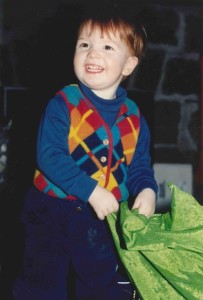 Eighteen years ago, my son Danny taught me everything I needed to know about customer journeys.
Eighteen years ago, my son Danny taught me everything I needed to know about customer journeys.
At just three years old, Danny wasn’t a verbose child. So when he talked, we paid special attention. One night when we put him to bed, he put his hands over his crotch and simply said, “Hurts.”
If you’ve ever had a 3-year-old, you can understand how we felt. We called the nurse line, who instructed us to take him to the emergency room right away. Panicked, we grabbed the diaper bag and headed to the nearest hospital that took our insurance.
As we got there, they instructed us to fill out the paperwork, then rushed us back to another waiting room. But this one was dark and abandoned – just one light in the corner. The staff person asked us to wait there until they could find a doctor. So we sat down, and I held Danny in my arms, whimpering. And we proceeded to wait.
After a half-hour, I was frustrated beyond belief. Anxious, scared. So I went to find some help. Eventually, I was told to go back, as they were still looking for a doctor. So I went back, and we continued to wait.
Finally, after an hour in the hospital (which felt much longer), the original staff person came back and said, “We think you should take your son to Children’s Hospital.”
Of course we agreed. And so we headed to another hospital.
As we got there, we were met at the entry by a staff person who was expecting us (we’d called ahead). She welcomed us, and told us that they had a room ready for Danny, but they needed one of us to fill out the paperwork. So I sent my wife Sue in, and filled out the paperwork. Once done, I rushed into the room, and what did I see?
Danny was sitting on Sue’s lap, and she was reading him a story. (Why didn’t we read a story in the first hospital? We were in such a hurry that we forgot to bring them.) The nurse brought me a cup of water, and told me the doctor was in surgery, and it would be at least an hour before he could be there.
We waited, and it was actually just a bit over an hour. Finally, the doctor came over to examine Danny.
—————–
Before getting to the punch line, let’s look at each of these hospitals. Both were focused on solving the problem of a shortage of doctors. The difference is that this is all the first hospital focused on. Children’s Hospital was also managing the problem of doctor availability – but also anticipated our needs, and helped to calm an anxious couple.
While Children’s Hospital obviously works primarily with children, the first hospital has no shortage of kids. Obviously, Children’s had worked through the journey, and came up with plans to help ease a hurting child. But even though they aren’t exclusively focused on children, the first hospital still had child patients, so should have had books and other distractions. But they obviously hadn’t walked through the journey the way Children’s had.
Also, notice the role of the nurse at Children’s. Instead of leaving me guessing when a doctor would be available, she set my expectations so I knew how long I would have to wait. Waiting is one of the worst parts of any experience – but it’s far worse when you don’t know how long it will be.
—————–
Here’s the kicker. The doctor looked at Danny, and determined it was a temporary problem. No treatment was necessary.
So we have two hospitals. Neither solved my problem. The first hospital didn’t charge me – but the second one did!
In a rational world I would be mad at Children’s Hospital. But because they understood the journey and anticipated my needs, I rave about them 18 years later. Whereas you’ll notice I don’t even give the name of the first hospital, and we haven’t gone there since.
So, what are the lessons I learned that night?
- Bad experiences aren’t designed badly. Bad experiences are undesigned. Nobody created a plan that featured putting us in an abandoned waiting room with only one light and no distractions for Danny. The reason for this bad experience is because nobody took the time to plan out what to do.
- A little kindness goes a long way. I can still vividly remember the nurse bringing me that water. It was a welcome human touch after the dehumanizing experience at the other hospital.
- Nothing is worse than waiting. Except waiting with no idea of how much longer you’ll have to wait.
These same lessons have played out in multiple journeys – from health insurance to retail to health clubs. They don’t always have the same level of anxiety as that night in the dark waiting room. But every journey suffers from a lack of design, and the worst times can be made a bit better through a kind employee.
That’s why we do journey mapping.
So, your question: Are you leaving your customers in a dark room?



